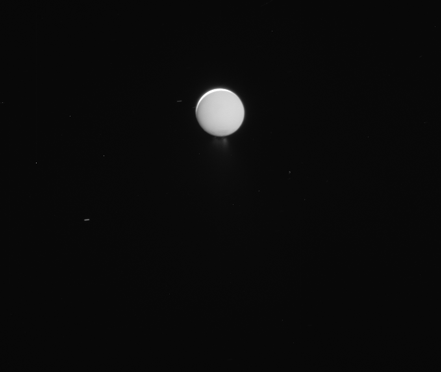The Shuttle Atlantis Seen In Silhouette During Solar Transit, May 12, 2009. Image By NASA/Thierry Legault.

The Shuttle Atlantis seen in silhouette during solar transit, May 12, 2009. Image by NASA/Thierry Legault.
(NASA)
More Posts from Cozy-airlessness and Others

S.2.186
instagram: @fesq.project
me: *is bored for 0.5 seconds*
me: i wanna learn how to work wood. i need to build a boat


This movie sequence of images is from the last dedicated observation of the Enceladus plume by NASA’s Cassini spacecraft. Credit: NASA/JPL

Doug McLeod ‘Outbound’ (1988). From the book Visions of Space by David Hardy (1989)

Peripheral vision. Anna Lee Fisher prepares for the 14th mission in Space Shuttle history & the 2nd of Discovery, Nov 1984. Dr. Fisher spent 8 days in space during her career & also assisted in the development of the Canadarm & the design of spacesuits for women. Selected as an astronaut candidate in 1978, her other accomplishments include being a Doctor of Medicine & a Masters in Science graduate.

A man takes a picture from a rooftop as the Endeavour Space Shuttle makes its way toward the California Science Center on October 13, 2012.⠀ ⠀ Via Time and Photographer Rick Loomis-Pool
There's this sort of anthropomorphizing that inherently happens in language that really gets me sometimes. I'm still not over the terminology of "gravity assist," the technique where we launch satellites into the orbit of other planets so that we can build momentum via the astounding and literally astronomical strength of their gravitational forces, to "slingshot" them into the direction we need with a speed that we could never, ever, ever create ourselves. I mean, some of these slingshots easily get probes hurtling through space at tens of thousands of miles per hour. Wikipedia has a handy diagram of the Voyager 1 satellite doing such a thing.

"Gravity assist." "Slingshot." Of course, on a very basic and objective level, yes, we are taking advantage of forces generated by outside objects to specifically help in our goals. We're getting help from objects in the same way a river can power a mill. And of course we call it a "slingshot," because the motion is very similar (mentally at least; I can't be sure about the exact physics).
Plus, especially compared to the other sciences, the terminology for astrophysics is like, really straightforward. "Black hole?" Damn yeah it sure is. "Big bang?" It sure was. "Galactic cluster?" Buddy you're never gonna guess what this is. I think it's an effect of the fact that language is generally developed for life on earth and all the strange variances that happen on its surface, that applying it to something as alien and vast as space, general terms tend to suffice very well in a lot more places than, like... idk, botany.
But, like. "Gravity assist." I still can't get the notion out of my head that such language implies us receiving active help from our celestial neighbors. They come to our aid. We are working together. We are assisted. Jupiter and the other planets saw our little messengers coming from its pale blue molecular cousin, and we set up the physics just right, so that they could help us send them out to far stranger places than this, to tell us all about what they find out there.
We are assisted.
And there is no better way to illustrate my feelings on the matter than to just show you guys one of my favorite paintings, this 1973 NASA art by Rick Guidice to show the Pioneer probe doing this exact thing:

"... You, sent out beyond your recall, go to the limits of your longing. Embody me. ..."
Gravity assist.








For All Mankind (1.03 "Nixon's Women") Sonya Walger as Molly Cobb








We love you, Neil.
-
 aimlessentries liked this · 3 weeks ago
aimlessentries liked this · 3 weeks ago -
 flackaszn liked this · 3 weeks ago
flackaszn liked this · 3 weeks ago -
 slumsaintt reblogged this · 3 weeks ago
slumsaintt reblogged this · 3 weeks ago -
 nelc liked this · 4 months ago
nelc liked this · 4 months ago -
 syancee liked this · 5 months ago
syancee liked this · 5 months ago -
 dogpes liked this · 6 months ago
dogpes liked this · 6 months ago -
 youarenotyourblog reblogged this · 7 months ago
youarenotyourblog reblogged this · 7 months ago -
 rawfuel reblogged this · 7 months ago
rawfuel reblogged this · 7 months ago -
 delicatesoundofathunder liked this · 9 months ago
delicatesoundofathunder liked this · 9 months ago -
 uveau reblogged this · 9 months ago
uveau reblogged this · 9 months ago -
 neuuuurotica liked this · 10 months ago
neuuuurotica liked this · 10 months ago -
 saphirabluish reblogged this · 10 months ago
saphirabluish reblogged this · 10 months ago -
 totallybemused liked this · 11 months ago
totallybemused liked this · 11 months ago -
 saphirabluish liked this · 11 months ago
saphirabluish liked this · 11 months ago -
 spockvarietyhour liked this · 11 months ago
spockvarietyhour liked this · 11 months ago -
 amorettea liked this · 11 months ago
amorettea liked this · 11 months ago -
 kntryradiotexas reblogged this · 11 months ago
kntryradiotexas reblogged this · 11 months ago -
 dzkat2 liked this · 11 months ago
dzkat2 liked this · 11 months ago -
 elyccscorner liked this · 11 months ago
elyccscorner liked this · 11 months ago -
 thesmilingfish reblogged this · 11 months ago
thesmilingfish reblogged this · 11 months ago -
 thesmilingfish liked this · 11 months ago
thesmilingfish liked this · 11 months ago -
 thelateandboggythagsimmons liked this · 11 months ago
thelateandboggythagsimmons liked this · 11 months ago -
 dontforgettobenerdy liked this · 11 months ago
dontforgettobenerdy liked this · 11 months ago -
 number1dork liked this · 11 months ago
number1dork liked this · 11 months ago -
 aerialworms reblogged this · 11 months ago
aerialworms reblogged this · 11 months ago -
 the-tomorrow-road reblogged this · 11 months ago
the-tomorrow-road reblogged this · 11 months ago -
 the-tomorrow-road liked this · 11 months ago
the-tomorrow-road liked this · 11 months ago -
 the-crooked-library liked this · 11 months ago
the-crooked-library liked this · 11 months ago -
 nival-kenival liked this · 11 months ago
nival-kenival liked this · 11 months ago -
 ghostlyarchaeologist reblogged this · 11 months ago
ghostlyarchaeologist reblogged this · 11 months ago -
 ghostlyarchaeologist liked this · 11 months ago
ghostlyarchaeologist liked this · 11 months ago -
 stars-over-new-jersey reblogged this · 11 months ago
stars-over-new-jersey reblogged this · 11 months ago -
 ban-me-not reblogged this · 11 months ago
ban-me-not reblogged this · 11 months ago -
 ban-me-not liked this · 11 months ago
ban-me-not liked this · 11 months ago -
 tumbleweed-chaser liked this · 11 months ago
tumbleweed-chaser liked this · 11 months ago -
 if-6-was-9 liked this · 1 year ago
if-6-was-9 liked this · 1 year ago -
 frankkorzo reblogged this · 1 year ago
frankkorzo reblogged this · 1 year ago -
 rickb2016 liked this · 1 year ago
rickb2016 liked this · 1 year ago -
 angryddeer liked this · 1 year ago
angryddeer liked this · 1 year ago -
 dapperdan70 liked this · 1 year ago
dapperdan70 liked this · 1 year ago -
 elmermeromero liked this · 1 year ago
elmermeromero liked this · 1 year ago -
 gothware reblogged this · 1 year ago
gothware reblogged this · 1 year ago -
 spookypolicearbiter liked this · 1 year ago
spookypolicearbiter liked this · 1 year ago -
 lanc3r liked this · 1 year ago
lanc3r liked this · 1 year ago -
 jamesmcclure liked this · 1 year ago
jamesmcclure liked this · 1 year ago -
 scudrunner13 liked this · 1 year ago
scudrunner13 liked this · 1 year ago -
 whitemiata liked this · 1 year ago
whitemiata liked this · 1 year ago

21 · female · diagnosed asperger'sThe vacuum of outer space feels so comfy :)
233 posts